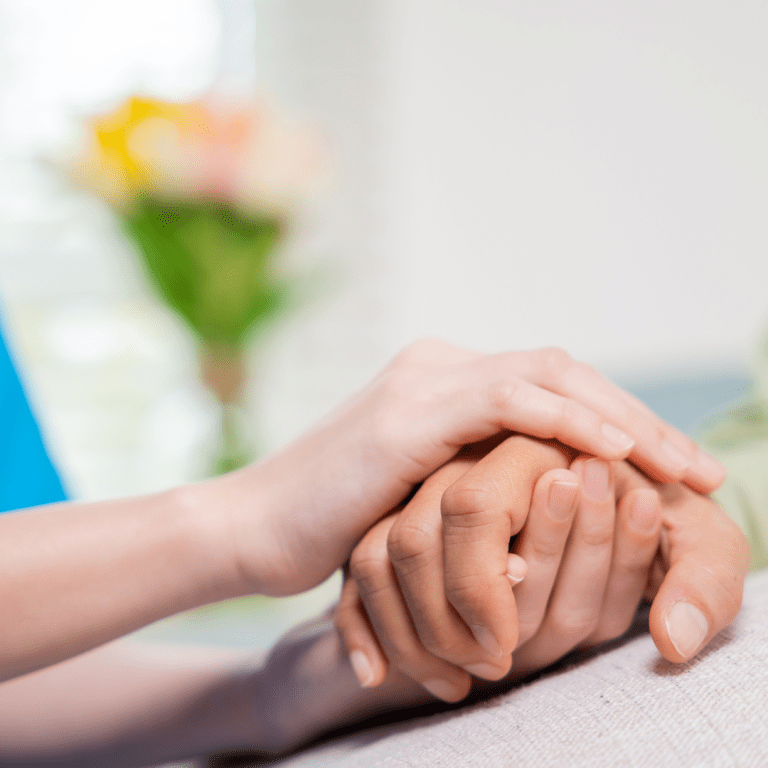
by Linda Lee
We are all likely to become caregivers at various points in our lives, whether it’s for a child who is ill, an aging parent, or a beloved spouse. There are many commonalities between caregivers and individuals who are grieving. In fact, caregivers are experiencing at least a temporary loss of a life that was in the past or was dreamed about for the future.
Like someone who is grieving, caregivers often experience negative emotional, physical, and cognitive effects. For example, they may feel fearful, isolated, and sad; be tired and undernourished; and have trouble concentrating or adapting to their new reality. They may feel like they are barely putting one foot in front of the other as they face overwhelming tasks and obstacles.
These effects may be most pronounced if their loved one’s needs came on suddenly, such as from a traumatic event. They may be thrown into caregiving before they have time to process the changes. Conversely, those who are caregiving for prolonged periods of time may lose the strength and stamina needed to maintain it.
Caregivers may look like the people we always knew, but they are not the same. They are living through a stressful, draining, major shift in their lives. Given this background, let us examine some potential problems with two statements caregivers often hear.
Statement 1: “Let Me Know if There’s Anything I Can Do”
How often have we said this to individuals who are experiencing challenges in life? We make our offer with sincerity and love. We truly want to step in to support them.
Unfortunately, this statement typically goes unheeded. The first reason is that caregivers may not realize what they need. Managing the immediate tasks in front of them, especially if they are in a crisis, may make it impossible to step back and reflect on what may ease their burdens. Secondly, few people find it easy to ask for help, and this request forces the caregiver to generate an idea and make the contact. Those who consider themselves relatively independent may hesitate turning to others. Asking for help requires strength and vulnerability they may not be capable of generating.
Instead, supporters can try to be proactive and a little creative. We can watch and listen for ways to help ease the caregiver’s daily schedule. We may suggest something specific such as, “I want to babysit for a few hours (or bring you Sunday dinners or pick up your groceries) while your loved one is ill to give you more time. Please allow me to do this. It would make me feel good to be part of the care you’re providing.” This type of statement offers a specific idea and makes it clear that we want to do the task. We also can be ready to jump in if the caregiver expresses a wish, even in an offhanded way. Or, if we see that something like lawn care is needed and think they would be receptive, we can pull their weeds or cut their grass without asking. Ideally, such support will continue beyond the initial period. However, if we’re not able to make an ongoing commitment, we can still make occasional specific offers that can help for that moment.
We may also provide support by calling, dropping off a treat, or sending messages and cards. Any of these gestures demonstrate our love for the individuals who are ill and those who are caring for them. Our actions recognize that they are going through a challenging time and accompany them on their journey. We can acknowledge their courage and strength as they face it. We can make them feel less alone.
Finally, supporters should try not to take it personally if the caregivers don’t remember to thank us for what we’ve done. We need to remember the challenges of their situation and know without hearing it that the things we did likely provided at least a few moments of relief and comfort.
Statement 2: “You Need to Take Care of Yourself”
As I was caregiving for my spouse, Carol, prior to her death, I heard this advice regularly from my friends and family. It usually was thrown out to me in love and concern at the end of a conversation. I had said it to others myself in the past, although I only will again after carefully examining their circumstances and what I could do to help them achieve that goal. In theory, it makes perfect sense. You don’t have the strength to take care of someone else, and you run the risk of becoming ill, if you don’t nurture your body, mind, and spirit.
The statement assumes that the caregiver can (or wants to) alter their established pattern and has the means to make the change happen. Everyone who said it to me was familiar with my abilities to strategize and solve problems, so they assumed I could figure out ways to care for Carol and myself simultaneously. I knew I was pushing myself hard, although I didn’t realize the extent of it at the time. I was too caught up in getting through each moment to step back and design a way to ease up. I also admit that my fierce resolve to take care of everything may have kept me from actively examining other possibilities. I had spent a lifetime successfully rising to meet obstacles.
As Carol’s abilities declined, life felt like being on a treadmill that moved a little faster each time I added a new responsibility to my days and nights. I was trying to maintain her treatment and medication schedule, help her with personal care, ease her anxieties (as well as my own), keep others informed, get food and supplies, consult with her doctors and pharmacists, cook for us, take care of our house and yard, and work my part-time job. The ever-increasing list of things to do was in direct opposition to a progressive decline in my energy reserves. I was losing weight that I couldn’t afford to lose as I struggled to keep up. Throughout life, we were each other’s rock as well as soft place to fall. I wanted that to continue—not because I was trying to be a martyr, but because that’s what we always were for each other. Unfortunately, what I wanted to do for her and what I was physically capable of doing were beginning to be at odds.
In retrospect, I should have asked for help with errands, accepted more offers for aid, and hired others to do maintenance. Honestly, it didn’t even occur to me to sign up for home deliveries or hire people to do some chores. Some people may not have the option to hire helpers; they also may be working more hours than I was and have other dependents under their care, making life even more challenging.
I can’t emphasize enough that I wasn’t in my usual problem-solving mode. I was in one-minute-at-a-time survival mode. There’s a huge difference. As hospice care specialists Maggie Callanan and Patricia Kelley said, “Families are frequently tired and it’s a massive job merely to focus on a particular day or a given moment. The future holds grief and loss, so many families and friends avoid looking ahead.”[1]
I worked hard at not looking ahead by trying to keep my mind on the present moment with Carol. The concept of parting from each other was unimaginable. When those painful thoughts appeared, I concentrated on her face or how her hand felt in mine and tried to pull myself back to the present. She was very good at encouraging me to do so. She often said, “We know it’s going to be hard to face what’s ahead of us. Don’t live through it more than once.” Don’t live through it more than once… such wise words, but so difficult to do.
I had a hard time not breaking down (usually I did) if anyone turned the focus on me. I was strong as long as everything was centered on Carol, but if someone asked how I was doing, it was like they opened a door that otherwise was blocked.
I used myself as an example for this self-care statement to show the state of mind the caregiver may be in when we recommend it. Yes, self-care is vitally important, but the reality may not be possible without practical aid.
This is another example of how others may need to be creative in their efforts to support caregivers. As we think about what these individuals may need so they can better care for themselves, perhaps we can take one task off their list or sit with their loved one to give them some time to do it. If they resist help, we may want to keep trying. They may be more receptive later in their journey.
Finally, I would like to turn the focus on the caregivers, who need to be open to receiving the support that’s offered. It may be difficult to be open to it. Many people are stubborn in their desire to be independent and handle everything themselves (myself included). But these offers are gifts of love. They should be viewed in that light and accepted in kind.
Frank Ostaseski, an end-of-life care specialist and hospice founder, reminds us of the ideal goal for all who support the person who is ill:
In caring for someone who is sick, we use the strength of our arms and backs to move a patient from the bed to the commode. We lend the patient our bodies. We can also lend people the concentration of our minds and the fearlessness of our hearts. We can be a reminder of stability and confidence. We can expand our hearts in such a way that it can inspire the individual who is struggling to do likewise. Then we become a compassionate refuge.[2]
It takes a collaborative effort to reach this goal. Hopefully, everyone who loves this individual will realize the value of joining forces to create a refuge that supports each person involved.

This is the first installment in a series of articles Linda is writing for caregivers and family and friends who wish to support them.
Read the second installment HERE. | Read the third installment HERE. | Read the fourth installment HERE.
Linda Lee, PhD, is a published author and retired professor and research editor. She has offered workshops for The Yoga Sanctuary and other organizations, including Tidewell Hospice. In this series, she will present guidelines she developed following the loss of her spouse, through her training as a Tidewell volunteer, and from the grief literature.
_________________________________________________________________________
[1] Maggie Callanan and Patrick Kelley, Final Gifts: Understanding the Special Awareness, Needs, and Communications of the Dying (New York: Simon and Schuster, 2012), 105, NOOK.
[2] Frank Ostaseski, The Five Invitations: Discovering What Death Can Teach Us About Living Fully (New York: Flatiron Books, 2017), 125, NOOK.
